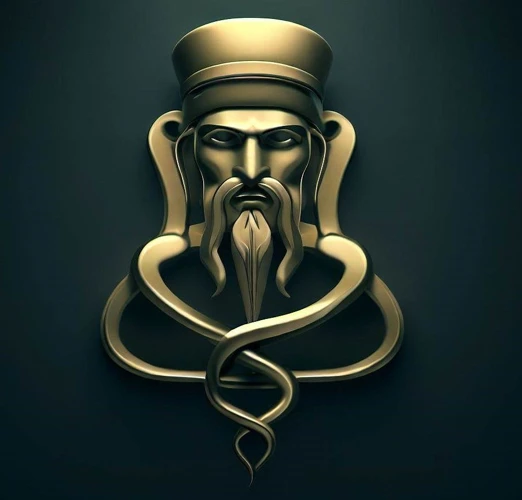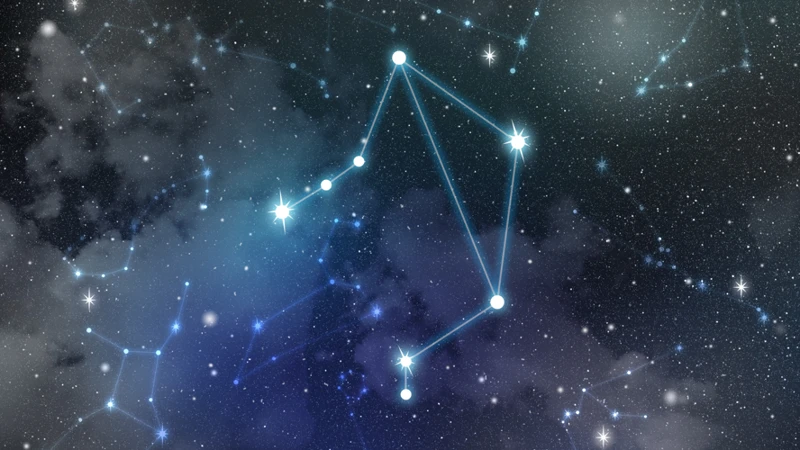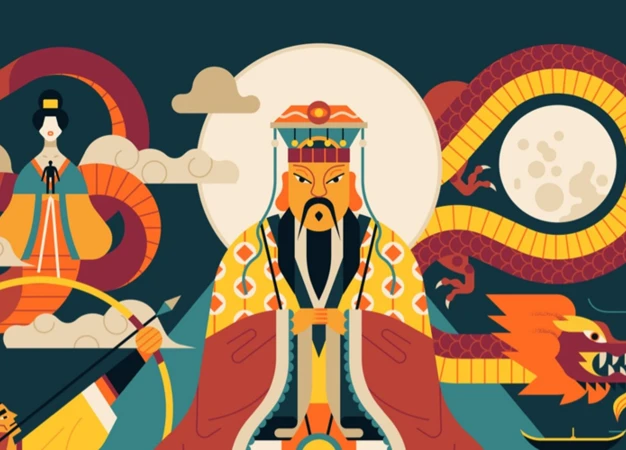China, a land steeped in rich history and cultural traditions, has a mythical past that is filled with fascinating legends and captivating tales. Exploring the origins of Chinese mythology takes us on a wondrous journey through ancient times, where mythical creatures roamed the land and powerful deities ruled the heavens. From the creation myth that tells the story of Pangu and the birth of the world, to the legendary figures like Emperor Yao and the mischievous Monkey King, Chinese mythology is a tapestry of colorful characters and enchanting narratives. Throughout this article, we will delve into the depths of Chinese mythology, uncovering the stories of gods and goddesses, legendary creatures, and the profound influence they have had on Chinese culture and art. Join us on this extraordinary adventure as we unlock the secrets of the origins of Chinese mythology.
1. The Creation Myth

At the heart of Chinese mythology lies the captivating tale of creation, which weaves a fantastical narrative of the birth of the world. One prominent version of the creation myth tells the story of Pangu, a primal being who emerged from chaos. As Pangu slept, the Yin and Yang energy within him, represented by a cosmic egg, began to separate, giving birth to heaven and earth. Pangu’s colossal body stretched out, forming the mountains and rivers, while his breath became the wind and clouds. After 18,000 years, Pangu’s body transformed into the myriad elements that make up the world. Another influential figure in the creation myth is Nuwa, the goddess of creation. Legend has it that she molded figures out of yellow clay, breathing life into them and populating the earth. The creation myth provides a mesmerizing foundation for the origins of Chinese mythology and sets the stage for the countless legends and tales that follow. Explore more about /chinese-zodiac-unraveling-mystery/.
1.1 Pangu and the Birth of the World
In the grand tapestry of Chinese mythology, the story of Pangu and the Birth of the World is a tale that captures the imagination and sparks curiosity. According to this ancient legend, at the beginning of time, there was only chaos – a swirling mass of Yin and Yang energies. From within this chaos, Pangu, a primordial being, emerged. Pangu took the form of a giant with an awe-inspiring stature, his body reaching the furthest realms of heaven and earth. Gripping a mighty axe in his hand, Pangu set out to separate the Yin and Yang energies, giving birth to creation itself. With each swing of his axe, Pangu cleaved the chaos and created the very foundation of the world. His breath transformed into the winds and clouds, his voice reverberated as thunder, and his body became the mountains and rivers. Pangu’s tremendous efforts lasted for a staggering 18,000 years until he finally lay down to rest, and his body evolved into the elements that shape our world. The flecks of his hair turned into the stars, his tears formed lakes and oceans, and his breath became the gentle breeze that caresses the earth. Pangu, through his immense power and sacrifice, brought order and harmony to the once chaotic world, laying the groundwork for life and civilization to flourish. This mesmerizing tale of Pangu and the Birth of the World is just the beginning of the intricate web of Chinese mythology, where countless other captivating stories await exploration. Learn more about the symbolism of /chinese-mythical-creatures-symbolism/.
1.2 Nuwa: The Goddess of Creation
In Chinese mythology, Nuwa holds a significant role as the goddess of creation. Often depicted as a beautiful and compassionate deity, Nuwa is credited with the formation of humanity and the restoration of order after a great catastrophe. According to legend, Nuwa was not only responsible for sculpting figures out of yellow clay but also anointed them with her divine breath, granting them life and consciousness. As the mother of humankind, Nuwa played a crucial role in ensuring the continuation and prosperity of the human race. In addition to her creative abilities, Nuwa is also associated with the repair of the celestial realm. It is said that when the pillars supporting the heavens were damaged, causing chaos and instability in the world, Nuwa melted and molded colored stones to repair the pillars, restoring harmony to the cosmos. Nuwa’s actions represent her unwavering dedication to maintaining balance and harmony in both the earthly and heavenly realms.
The story of Nuwa exemplifies the reverence and admiration that ancient Chinese culture had for the forces of creation and the divine feminine. Nuwa’s role as a mother figure and her ability to shape the destiny of humanity resonated deeply with the Chinese people, highlighting the importance of family, unity, and the preservation of life. Today, Nuwa’s influence can still be seen in Chinese culture, where she is revered as a symbol of love, compassion, and the powerful connection between humanity and the divine. To further explore the mythical mysteries of ancient China, journey into the fascinating world of the /terracotta-army-mythical-warriors/, where thousands of intricately crafted terracotta warriors stand as a testament to the historical and mythical traditions of the Chinese civilization.
2. Historical Legends and Heroes

Chinese mythology is not only filled with mythical creatures and divine beings, but it also encompasses a rich tapestry of historical legends and heroic figures. Within this realm of legends, two prominent figures emerge – Emperor Yao and King Yu. Emperor Yao is revered as one of the wisest and most benevolent rulers in Chinese history. He was known for his just governance, harmonious society, and exceptional moral character. Legend has it that he abdicated the throne to the worthy Shun, showcasing his selflessness and dedication to the prosperity of the realm. King Yu, on the other hand, is celebrated for his heroic efforts in battling the colossal Great Flood that ravaged the land. With his ingenuity and relentless determination, King Yu successfully controlled the floodwaters, saving countless lives and establishing himself as a legendary hero. These historical legends and heroes not only captivate our imaginations but also provide glimpses into the values and virtues cherished by the Chinese people throughout history. Discover more about the mythical warriors of China through the /terracotta-army-mythical-warriors/.
2.1 The Legendary Emperor Yao
In the rich tapestry of Chinese mythology, one of the most revered figures is the legendary Emperor Yao. Recognized as one of the “Three August Ones” and the “Five Emperors,” Emperor Yao is renowned for his wise and just rule during the ancient times. According to legend, Yao possessed extraordinary virtues and possessed a deep understanding of the cosmic order. He implemented a system of governance that promoted harmony, justice, and compassion, earning him the admiration and respect of his subjects. Emperor Yao is also known for his profound knowledge and mastery of the arts of divination and astrology. His reign is said to have been marked by an era of prosperity and peace. Despite facing numerous trials and challenges, Emperor Yao’s wise leadership and benevolence guided the ancient Chinese civilization through turbulent times. His legacy continues to inspire and influence Chinese culture to this day, serving as a reminder of the importance of virtuous leadership and harmonious governance.
2.2 The Mythical King Yu and the Great Flood
In Chinese mythology, the tale of King Yu and the Great Flood is a legendary story that showcases heroism and divine intervention. According to ancient texts, the world was plagued by incessant flooding, causing chaos and devastation. King Yu, known for his wisdom and dedication, took upon himself the monumental task of controlling the floodwaters. With unwavering determination, he led a team of skilled workers in dredging rivers, constructing channels, and dividing the land into nine provinces. It is believed that King Yu spent thirteen long years tirelessly working to bring order and stability to the land. His perseverance and diligence earned him the admiration of the gods, who witnessed his selfless efforts. Eventually, the floodwaters receded, and King Yu’s success brought peace and prosperity to the realm. This heroic feat of overcoming immense natural forces has become an enduring symbol of resilience and the triumph of good over adversity in Chinese mythology. The story of King Yu’s triumph over the Great Flood is an integral part of China’s cultural heritage and serves as a testament to the indomitable spirit of its people. Visit /chinese-mythical-creatures-symbolism/ to learn more about mythical creatures in Chinese mythology.
2.3 The Divine Archer Houyi and the Ten Suns
In the vast realm of Chinese mythology, the tale of The Divine Archer Houyi and the Ten Suns stands out as an extraordinary legend of bravery and celestial intervention. According to ancient folklore, there was a time when ten suns blazed in the sky, scorching the Earth and causing havoc. The relentless heat and drought threatened the existence of all living beings. In response to this dire situation, the divine archer Houyi stepped forward as humanity’s greatest hope for salvation.
Houyi, renowned for his exceptional archery skills, was chosen by the heavens to restore balance. With his trusty bow and arrow, he embarked on a mission to shoot down the ten suns. With each arrow released from his mighty bow, a sun plummeted from the sky, gradually restoring peace and prosperity to the world.
However, the extraordinary feat came at a great cost. As the suns fell, the divine energy they possessed was released, and Houyi’s wife, the beautiful Chang’e, accidentally consumed some of this potent essence. The divine energy caused her to transcend her mortal form, ascending to the moon where she became the goddess of the Moon.
Houyi’s tale resonates with themes of sacrifice, bravery, and the balance between heaven and Earth. His selflessness in taking on the task of shooting down the suns highlights the virtues held dear by the Chinese culture. Today, the story of Houyi and the ten suns continues to inspire countless works of art, including paintings, sculptures, and traditional performances.
The prominence of Houyi and his myth can also be seen in the celebration of the Mid-Autumn Festival, where people gather to enjoy mooncakes and gaze at the full moon, paying homage to Chang’e, the Moon Goddess, and her eternal love for her heroic husband.
The legend of The Divine Archer Houyi and the Ten Suns serves as a reminder of the profound impact that Chinese mythology has had on shaping cultural beliefs and practices. It stands as a testament to the enduring power of ancient legends, which continue to captivate and inspire generations of people to this day.
3. Folklore and Legendary Creatures

Embark on a journey through Chinese folklore and discover a captivating world filled with legendary creatures that have captured the imagination of people for centuries. Among these mythical beings is the powerful and awe-inspiring Dragon, a symbol of power, strength, and good fortune in Chinese culture. With its serpentine body and majestic presence, the Dragon is believed to bring prosperity and ward off evil spirits. Equally enchanting is the Phoenix, a mythical bird that represents rebirth and prosperity. Its vibrant plumage and graceful demeanor make it an emblem of beauty and grace. And let us not forget the Qilin, a legendary creature known for its wisdom and serenity. With the head of a dragon, the body of a deer, and the tail of an ox, the Qilin is believed to bring blessings and good fortune. Delve deeper into the symbolism and significance of these mythical creatures in Chinese culture and uncover the interconnectedness between folklore and the everyday lives of the Chinese people. Learn more about Chinese mythical creatures and their symbolism /chinese-mythical-creatures-symbolism/.
3.1 The Dragon: Symbol of Power and Good Fortune
The dragon holds a prominent place in Chinese mythology, revered as a symbol of power, wisdom, and good fortune. In Chinese culture, dragons are not seen as menacing creatures, but rather as benevolent beings associated with prosperity and auspiciousness. Dragons are believed to have control over the elements, capable of summoning rain for a bountiful harvest, and ruling over bodies of water. They are often depicted with a majestic appearance, featuring a long serpentine body, sharp claws, and a magnificent scaly exterior. The dragon’s association with power is exemplified by its close ties to the emperor, who was considered the ‘Son of the Dragon’. In imperial China, the emperor’s throne was known as the Dragon Throne, and the imperial robes were adorned with dragon motifs. Even today, dragons continue to be revered in Chinese culture, with dragon dances and dragon boat festivals being celebrated during important events and holidays. Their presence in art, architecture, and even on Chinese currency further showcases the enduring symbolism of the dragon. Explore more about Chinese mythical creatures and their symbolism /chinese-mythical-creatures-symbolism/.
3.2 The Phoenix: Symbol of Rebirth and Prosperity
The phoenix, a legendary creature in Chinese mythology, holds a prominent place as a symbol of rebirth and prosperity. Revered for its beauty and grace, the phoenix is believed to rise from the ashes, representing the cycle of life and the triumph over adversity. According to ancient legends, the phoenix’s vibrant plumage is said to contain five colors – black, white, green, red, and yellow – each representing a different virtue. The black feathers symbolize virtue, the white feathers represent righteousness, the green feathers embody kindness, the red feathers signify propriety, and the yellow feathers represent sincerity. With its majestic presence and auspicious symbolism, the phoenix is often associated with the empress and is regarded as a symbol of feminine power and grace. The phoenix is believed to bring good fortune and prosperity, making it a popular motif in Chinese art, architecture, and folklore. Its image can be found adorning ancient tapestries, imperial robes, and even currency. The phoenix’s significance in Chinese culture extends beyond mythology, reflecting the enduring values of resilience, renewal, and prosperity.
3.3 The Qilin: Legendary Creature of Wisdom and Serenity
The Qilin, also known as the Chinese Unicorn, is a legendary creature that holds immense significance in Chinese mythology. It is often depicted as a majestic hybrid creature with the body of a deer, the tail of an ox, the hooves of a horse, and a single horn on its forehead. The Qilin is believed to possess extraordinary powers and is regarded as a symbol of wisdom, serenity, and good fortune. According to ancient legends, the appearance of a Qilin is considered an auspicious omen, signaling the arrival of a virtuous ruler or a time of peace and prosperity. Its gentle and peaceful nature is said to bring harmony and tranquility wherever it goes. The Qilin is often portrayed in traditional Chinese art and is a popular motif in architecture, sculptures, and other forms of artistic expression. The Qilin’s representation in Chinese culture reflects the reverence and admiration for wisdom and spiritual insight. Its graceful and majestic presence continues to captivate the imagination and serves as a reminder of the importance of embracing inner peace and harmony in one’s life. Unleash the mysteries of other /chinese-mythical-creatures-symbolism/.
4. Mythological Gods and Goddesses

Within Chinese mythology, a pantheon of powerful gods and goddesses reigns over the heavens and influences the lives of mortals. One prominent deity is the Jade Emperor, revered as the ruler of the heavens and the highest divine being in Chinese mythology. Sitting atop a throne of pure jade, the Jade Emperor governs the realm of afterlife, fate, and celestial affairs. Another widely venerated figure is Guanyin, the goddess of mercy and compassion. With a gentle countenance and a thousand helping hands, Guanyin hears the pleas of the suffering and offers solace and aid to those in need. And let us not forget the mischievous and charismatic Sun Wukong, also known as the Monkey King. Endowed with supernatural abilities and armed with a magical staff, Sun Wukong embarks on epic adventures, challenging the gods and displaying his resourcefulness. These mythological gods and goddesses are not merely characters of ancient tales; they embody the values and beliefs of the Chinese people, serving as a source of inspiration and guidance. Discover more about the remarkable pantheon of Chinese mythological gods and goddesses.
4.1 The Jade Emperor: Ruler of the Heavens
In Chinese mythology, The Jade Emperor holds a position of supreme authority as the ruler of the heavens. Known as Yu Huang Shang Di in Mandarin, the Jade Emperor governs all realms of existence and is revered as the celestial deity who oversees the mortal world. He is often depicted as a wise and benevolent figure, adorned in regal jade robes that signify his divine status. As the ruler of the heavens, the Jade Emperor is responsible for maintaining order, justice, and harmony among gods, humans, and all living beings. His power is believed to be boundless, and his decisions are seen as final and just. In Chinese mythology, the Jade Emperor plays a significant role in various legends and stories, including his pivotal role in the legendary tale of the Great Race and the creation of the Chinese zodiac. The Jade Emperor’s influence permeates Chinese culture in numerous ways, from religious practices and festivals to art and literature. His image is often portrayed in temples, and his birthday is celebrated with grandeur and devotion during the Chinese New Year. The Jade Emperor’s enduring presence and importance in Chinese mythology make him a central figure in the pantheon of gods and a beloved symbol of power and divinity. Uncover more about Chinese mythical creatures and their symbolism /chinese-mythical-creatures-symbolism/.
4.2 Guanyin: Goddess of Mercy and Compassion
In Chinese mythology, Guanyin holds a revered position as the goddess of mercy and compassion. Also known as Guan Yin, or the Bodhisattva of Compassion, she is a widely worshipped deity in Buddhism and is believed to have the ability to hear the cries of the suffering and provide solace and relief. Guanyin is often depicted as a graceful figure, adorned in flowing robes and holding a willow branch or a vase containing pure water, symbolizing her ability to assist those in need. She is said to possess a thousand eyes, enabling her to see the suffering of the world, and a thousand hands, allowing her to offer aid to all who seek her help. Guanyin’s compassion knows no bounds, and she is revered as a universal goddess who transcends cultural and religious boundaries. Her influence can be seen in various aspects of Chinese culture, including art, literature, and even popular folklore. Explore more about mythical creatures in Chinese culture /chinese-mythical-creatures-symbolism/.
4.3 Sun Wukong: The Mischievous Monkey King
In Chinese mythology, one of the most renowned and beloved figures is Sun Wukong, better known as the Mischievous Monkey King. Sun Wukong is a central character in the classic novel “Journey to the West” and has captured the hearts and imaginations of people throughout the centuries. Born from a stone and granted immense powers, Sun Wukong is known for his mischievous nature, incredible strength, and rebellious spirit. With his agility and mastery of martial arts, he becomes a formidable opponent, often challenging the gods and wreaking havoc in heaven. One of Sun Wukong’s most iconic attributes is his weapon, the magic staff that can change size at his command. This staff becomes a symbol of his power and is instrumental in his extraordinary adventures. Sun Wukong’s mischievous antics and his journey to seek enlightenment alongside the Buddhist monk, Tripitaka, have become legendary. Through his trials and triumphs, Sun Wukong embodies the complex nature of humanity, with his flaws and strengths, reminding us of the power of transformation and redemption. The tale of the Mischievous Monkey King has left an indelible mark on Chinese culture and has been adapted into various forms of literature, theater, and modern media, solidifying Sun Wukong’s status as a beloved cultural icon.
5. Influence on Chinese Culture and Art
Chinese mythology has had a profound and enduring influence on Chinese culture and art. The rich tapestry of mythical characters, legends, and stories has become deeply ingrained in the collective consciousness of the Chinese people, shaping their beliefs, values, and traditions. One notable example is the influence of mythology on Chinese literature and poetry. Many renowned literary works, such as “Journey to the West” and “The Dream of the Red Chamber,” draw inspiration from mythological figures like the mischievous Monkey King, Sun Wukong. These stories not only entertain and captivate readers, but they also contain moral lessons and philosophical teachings that reflect the values and ideals of Chinese society.
Chinese mythology has inspired the creation of intricate and beautiful artistic expressions. Traditional Chinese painting often features mythical creatures, gods, and goddesses as subjects, capturing their power and essence on paper or silk. These artworks not only showcase the deep reverence for mythology but also serve as a means of communication, spreading the stories and teachings embedded within the myths to a wider audience.
Chinese mythology has greatly influenced the performing arts, especially in traditional Chinese opera. Characters from myths and legends are brought to life on the stage, with elaborate costumes and stylized movements that are steeped in symbolism. These performances not only entertain audiences but also serve as a medium for cultural preservation, ensuring that the stories and characters of Chinese mythology continue to be passed down through generations.
Chinese mythology has permeated everyday life in China, as evidenced by the presence of mythical creatures and gods in various aspects of Chinese culture. The Dragon, often associated with power and good fortune, is a prominent symbol seen in architecture, decorative objects, and even traditional festivals like Chinese New Year. The Phoenix, symbolizing rebirth and prosperity, is also frequently depicted in art and is a popular motif in Chinese textiles and jewelry.
The influence of Chinese mythology on Chinese culture and art is undeniable. Its impact can be seen in literature, visual arts, performing arts, and even in everyday life. By understanding and appreciating the origins and significance of these mythical tales and characters, we gain invaluable insights into the depth and richness of Chinese culture and artistic expression. Explore more about /chinese-mythical-creatures-symbolism/ and /terracotta-army-mythical-warriors/.
Conclusion
In conclusion, delving into the origins of Chinese mythology has been a captivating journey through ancient legends and fascinating tales. We have explored the creation myth, witnessing the birth of the world through the cosmic dance of Pangu and the creative prowess of Nuwa. These mythical stories have laid the groundwork for the rich tapestry of Chinese mythology, filled with larger-than-life characters and awe-inspiring adventures. From the legendary figures like Emperor Yao, who exemplified wisdom and benevolence, to the mythical King Yu, who saved the world from the devastating Great Flood, Chinese mythology is replete with heroes whose feats have endured throughout history. The fascinating folklore surrounding creatures like dragons, phoenixes, and qilins adds an element of mysticism and wonder to Chinese mythology. Additionally, the pantheon of gods and goddesses, including the mighty Jade Emperor, the compassionate Guanyin, and the mischievous Monkey King Sun Wukong, have left an indelible mark on Chinese culture and continue to be celebrated to this day. From artistic representations to cultural practices, Chinese mythology is deeply intertwined with the fabric of Chinese society. Its influence can be seen in various aspects of Chinese art, architecture, literature, and even the Chinese zodiac, which derives its inspiration from mythical creatures. The legacy of Chinese mythology serves as a testament to the enduring power of storytelling, the exploration of the human experience, and the boundless imagination of ancient civilizations. As we conclude our journey through the origins of Chinese mythology, we are reminded of the diverse and complex nature of human belief systems, which continue to shape and inspire us in the modern world.
Frequently Asked Questions
1. How old is Chinese mythology?
Chinese mythology dates back thousands of years, with origins rooted in ancient Chinese civilization. The exact age of Chinese mythology is difficult to determine, but it has been passed down through oral traditions and recorded texts for centuries.
2. Are Chinese mythology and Chinese folklore the same?
No, Chinese mythology and folklore are not the same, although they often overlap. Chinese mythology refers to the collection of myths, legends, and deities in Chinese culture, while Chinese folklore encompasses a broader range of traditional stories, customs, and beliefs.
3. Are there any female deities in Chinese mythology?
Absolutely! Chinese mythology includes several powerful female deities who play significant roles. Goddesses like Nuwa, Guanyin, and Nüwa are revered for their creative powers, compassion, and wisdom.
4. What are some famous mythical creatures in Chinese mythology?
Chinese mythology is teeming with fascinating mythical creatures. Dragons, phoenixes, and qilins are some of the most well-known and symbolically significant creatures in Chinese mythology. These legendary creatures often represent auspicious qualities and bring good fortune.
5. Who is the Monkey King in Chinese mythology?
The Monkey King, also known as Sun Wukong, is one of the most beloved figures in Chinese mythology. He is a mischievous and powerful immortal being who possesses incredible strength, agility, and magical abilities. Sun Wukong is a central character in the classic Chinese novel “Journey to the West.”
6. What is the significance of the Terracotta Army in Chinese mythology?
The Terracotta Army is not directly linked to Chinese mythology, but it holds immense historical and cultural significance. The army of terracotta warriors was built to accompany the first emperor of China, Qin Shi Huang, in the afterlife. Its discovery shed light on the rich history and artistry of ancient China.
7. How does Chinese mythology influence Chinese culture and art?
Chinese mythology has greatly influenced various aspects of Chinese culture and art. From traditional festivals and rituals to painting, sculpture, and literature, elements of Chinese mythology can be found in numerous artistic expressions, symbolizing cultural values, spiritual beliefs, and ancestral reverence.
8. What is the story of the Great Flood in Chinese mythology?
The story of the Great Flood in Chinese mythology revolves around the mythical King Yu. It is believed that floods ravaged the land, and King Yu successfully controlled and diverted the waters, earning him the title of a legendary hero. This story exemplifies the importance of diligence, perseverance, and the ability to overcome challenges.
9. How do Chinese zodiac animals relate to Chinese mythology?
The Chinese zodiac, consisting of twelve animal signs, has its roots in Chinese mythology. The story goes that these animals were chosen by the Jade Emperor in a race, and their order determined their position in the zodiac cycle. Each zodiac animal has its own significance and is believed to influence the character traits of individuals born under that sign.
10. Are there any real-world locations associated with Chinese mythology?
Yes, there are real-world locations associated with Chinese mythology. Mount Kunlun, said to be the dwelling place of immortals, is a prominent location in many myths. Other sacred mountains like Mount Tai, which is considered a celestial pillar, and Mount Hua, associated with the gods, hold spiritual and mythological significance.








